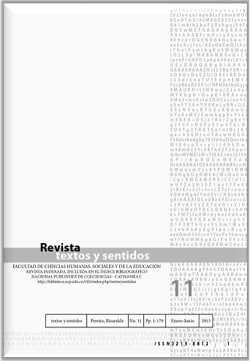Occurrence of corporal enjoyment. The invisible marks in the body of children and young. Brief psychoanalytic look
Keywords:
Body, Enjoyment, Impulse, Sublimation, Childhood, Youth, Psychoanalysis, Social ScienceAbstract
Different perspectives of human and social sciences have pointed out the way humans built and have a body; his instructions were aimed, mostly, to indicate that the body is constructed in its relations with the cultural, economic, political and social. Meanwhile, although the psychoanalytic proposal does not know at any moment the approaches of different sciences from the body, its emphasis on the analysis of the body that has been built by the subject from no visible marks, referred to event targets body enjoy, in the words of Jacques Lacan. Then, in this libidinal body, where they can think contemporary symptoms appearing today in childhood and youth, evidenced these in various sexual overflows that break down social ties and amorous human life. A psychoanalytic reading on these issues may present and propose new sublimatory routes (Art – Body) for children and young people in the subjectivity of today are subsumed in the victory of Death instinct and autistic, and deadly masturbatory pleasures.
References
Brehier, E. (2011) La teoría de los incorporales en el estoicismo antiguo. Posfacio de Jean Michel Vappereau. Traducción por Félix contreras y otros. Documento recuperado el día 3 de Enero del 2014 de la página web: http://www.teebuenosaires.com.ar/biblioteca/ trad_09.pdf
Donzis, L. (2014) Perversión Polimorfa infantil. Revista virtual Imago agenda. Tomado el 19/09/2014 9:45 a.m. de http://www. imagoagenda.com/articulo.asp?idarticulo=800
Freud, S. (1916) Conferencia 20. La vida sexual de los seres humanos. En: Obras completas Tomo XVI. Amorrortu editores, Buenos Aires. 1996.
Miller, J A. (2002) Biología lacaniana y acontecimiento del cuerpo. Biblioteca de la Colección Diva. Buenos Aires, Argentina
Lacan, J. (1949) El estadio del espejo como formador de la función del yo [je] tal como se nos revela en la experiencia psicoanalítica. En: Escritos 1. Siglo veintiuno editores. Buenos aires, Argentina. 1988.
______ (1953) Función y campo de la palabra y del lenguaje en psicoanálisis. En: Escritos 1. Siglo veintiuno editores. Buenos aires, Argentina. 1988.
______ (1960) Posición del inconsciente. En: Escritos 1. Siglo veintiuno editores. Buenos aires, Argentina. 2008.
Píngaro, N (2007) La creación literaria, un juego para des-encontrar la palabra. Editorial Letra Viva. Buenos Aires, Argentina.
Soler, C. (2013). El en-cuerpo del sujeto. Colección estudios de psicoanálisis. G.G Ediciones. Bogotá, Colombia.
_______ (2006) El cuerpo en la enseñanza de Jacques Lacan. En: Los ensamblajes del cuerpo. Edita Asociación Foros del campo lacaniano de Medellín. Medellín, Colombia.
Starobinski, J. (1981) Breve historia de la conciencia del cuerpo. En : Razones del cuerpo, Valladolid, Cuatro. Ediciones, 1999.
Zapata, J. (2013) El goce: eso de lo que hay que saber. Tomado el 19/09/2014 8:00 a.m. de Blog Nel Medellín, http://nel-medellin. org/blog/el-goce-eso-de-lo-que-hay-que-saber/

